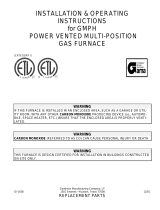
11
surface that the furnace is mounted on must provide sound
physical support of the unit. Secure the furnace to the floor.
• The furnace should be installed as close to the center of
the air distribution system as possible and attached to a
properly installed duct system. Do not use the back of
the furnace for return air. See page 9 & page 10
for circulating requirements.
• The furnace must be installed so that all electrical
components are protected from water.
• The plenum attached to the A/C coil box and ductwork
within 3 ft. of the furnace must be installed so that surfaces
are at least 1” from combustible construction.
• When installed in a residential garage, the furnace must
be positioned so the burners and the source of the ignition
are located no less than 18 inches above the floor and
protected from physical damage by vehicles.
• The furnace must be installed upstream from a refrigeration
system.
• The furnace requires special venting materials and
installation procedures. See page 8 & page 9 for
venting guidelines and specifications.
Upflow Furnaces
WARNING:
The furnace must not be installed directly on
carpeting, tile, or any combustible material other
than wood flooring. Failure to comply may result
in fire, property damage or personal injury.
*SA series gas furnaces are shipped with the bottom panel
installed as shown in Figure 18, (page 23). If the furnace
is installed with only side return air, the bottom panel must
not be removed. If the furnace is installed with bottom return
air, the bottom panel must be removed. See Bottom Panel
Removal on page 13.
Horizontal Furnaces
WARNING:
The furnace must not be installed directly on
carpeting, tile, or any combustible material other
than wood flooring.
• The *SA series gas furnace can be installed horizontally
(Figure 7) in an attic, basement, crawl space or alcove.
It can also be suspended from a ceiling in a basement
or utility room in either a right to left airflow or left to right
airflow as shown in Figure 8, (page 12).
• *SA series furnaces are shipped with the bottom panel
installed. If the furnace is installed horizontally, remove
the bottom panel from the furnace before attaching the
duct system. See Bottom Panel Removal on page 13.
• If installing the furnace with an evaporator coil (in an attic),
it is required that a drip pan be placed under the furnace. If
the installation is on a combustible platform (Figure 7), it is
recommended that the drip pan extend at least 12 inches
past the top and front of the furnace. NOTE: Although it is
not required to use a drip pan for heat only applications,
state and local codes may require it.
• If suspending the furnace from the ceiling, assemble a
support frame (Figure 8) using slotted iron channel and full
FURNACE INSTALLATION
These Installation procedures are suggested for typical
furnace installations. Since each installation is different,
the sequence of instructions may differ from the actual
installation. Only qualified HVAC technicians should
install this furnace.
The installer must be familiar with and comply with all codes
and regulations applicable to the installation of these heating
appliances and related equipment. In the absence of local
codes, the installation must be in accordance with the current
provisions of one or more of the following standards.
• American National Standard (ANSI-Z223.1/NFPA-54) and/
or CAN/CSA B149 for all gas-fired furnace models.
• American National Standard (ANSI-C1/NFPA-70) and/or
CSA 22.1 Canadian Electric Code Part 1 for all electrical
field wiring.
About The Furnace
The *SA / *SK series furnace is designed only for indoor
installations and can be readily connected to the high
static duct system of a home. *SA series gas furnaces are
shipped ready for installation in the upflow or horizontal
right or left positions. *SK series gas furnace may only be
used for downflow operation. Units are approved for single
/ multistory residential structures in freestanding /closet /
alcove configurations.
This appliance will provide many years of safe and dependable
comfort, providing it is properly installed and maintained.
Abuse, improper use, and/or improper maintenance can
shorten the life of the appliance and create unsafe hazards.
Please read all instructions before installing the unit.
Approved installation, operation, and maintenance of this
appliance must be in accordance with the listed specifications
contained in these instructions and other documents supplied
with the furnace and/or optional air conditioning equipment.
Unless it is noted differently in this manual, only use factory
authorized kits and accessories on this appliance. Refer to
local authorities having jurisdiction for further information.
Before You Install the Furnace
√ This equipment is securely packaged at the time of
shipment and upon arrival should be carefully inspected
for damage prior to installing the equipment at the job site.
Claims for damage (apparent or concealed) should be filed
immediately with the carrier.
√ Check the electrical supply and verify the power supply
is adequate for unit operation. The system must be wired
and provided with circuit protection in accordance with
local building codes. If there is any question concerning
the power supply, contact the local power company.
√ Verify the air delivery of the furnace is adequate to handle
the static pressure drop of the coil, filter, and duct work.
Locating the Furnace
• The dimensions of the room or alcove must be able to
accommodate the overall size of the furnace and required
clearances to combustible materials listed in Figure 1,
(page 5). Access for positioning and servicing must
also be considered when locating the unit. To determine
the required clearances needed for installation, refer to
Figure 18, (page 23) for overall dimensions.
• The furnace must be installed on a solid surface and must
be level front-to-back and side-to-side at installation. The




















